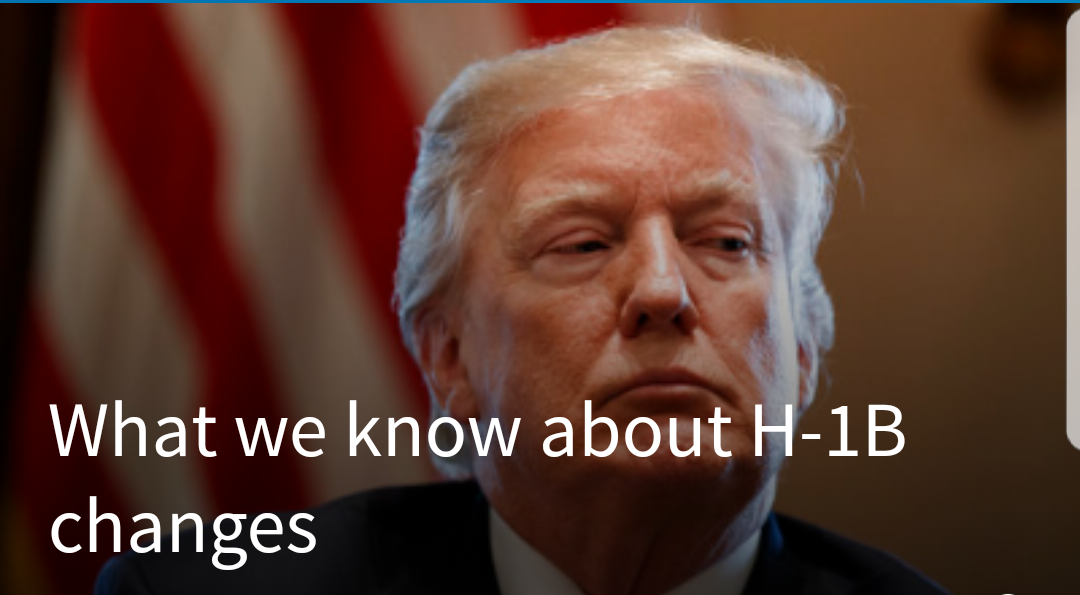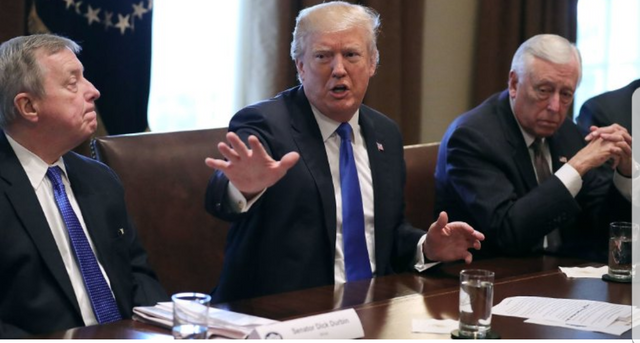President Trump’s plan for work visas: What we know and what we don't
President Trump’s plan for work visas: What we know and what we don't

This time last year, LinkedIn members were abuzz with questions and ideas about President Trump’s work-in-progress proposal for work visas. This year is no different.
After reports came out this month that the Trump administration was considering new regulations that would stop H-1B visa extensions and force foreign tech workers out of the country, more than 3,000 members weighed in. The Trump administration has since backed away from limiting visa extensions, but questions remain on where exactly immigration policy will go in 2018.
The Department of Homeland Security is still doing a thorough review of work visa programs, which makes understanding the current policies more important than ever. To get a better sense of what we know and what we don’t know about where the Trump administration stands when it comes to migrant workers, LinkedIn asked two leading experts with varying opinions to weigh in.
John Miano, a fellow at the Center for Immigration Studies, and Daniel Costa, the Director of Immigration Law and Policy Research at the Economic Policy Institute attempt to clear up some of the uncertainty around the current state of American foreign labor policy, as well as respond directly to some of the top comments from LinkedIn members.
Edited excerpts:
Caroline Fairchild: Why do you think the Trump administration and the U.S. Citizenship and Immigration Services have now come out so forcefully against the possibility of limited visas?
Daniel Costa: Either they never really considered it, or they considered it and were persuaded by the quick and very vocal backlash from the business community. Another possibility is that the administration realized that the change would not make much of a difference in practice, since as the USCIS representative notes in the McClatchy report yesterday:
“Even if it were, such a change would not likely result in these H-1B visa holders having to leave the United States because employers could request extensions in one-year increments under section 106(a)-(b) of AC21 instead.”
So, what the USCIS rep is saying is that the group of H-1B workers that would have lost the ability to extend their visas under the proposal that was reported on would no longer have been able to extend their visas three-years at a time while they waited for their green cards. But under another provision of the same AC21 law (section 106) those same H-1B workers waiting for green cards likely would have been able to renew their H-1Bs in one-year increments. Therefore, the practical impact of the policy change would not have been very significant.
John Miano: There are currently two possible extensions to the H-1B term. First, the Department of Homeland Security set the duration of H-1B at 3-years, with one 3-year extension. Second, Congress authorized the DHS to extend H-1B beyond the statutory maximum of 6 years to those with pending green card petitions. I had advocated for eliminating the first extensions and limit H-1Bs to one, three-year term. I do not know if the DHS is considering this. I hope so. However, notice that [today's Trump administration’s statement] does not include this change. A regulatory proposal to eliminate the second kind of extension was new to me. I had never raised it myself and had never heard anyone else raise it… Maybe it was never on the table.
Caroline Fairchild: How would limiting extensions have changed how American tech companies recruit talent?
Daniel Costa: A majority of the workers are coming in on H-1B are in the technology sector. It could have a couple of negative impacts, especially for the workers themselves. If tech companies want to recruit someone from India or China, companies might think that they have to find workers from a different country because there would be a lot of uncertainty if they can get a green card for that worker. Companies also might be discouraged from applying for permanent residence for their employers. They might just bring them in for a couple years and then rotate them out. If it is an employee that the employer likes, you would think that it would be good to keep them in the country. You could see a situation where you have more people rotating in and out of this temporary status.
John Miano: It would improve the technology industry by getting low-quality H-1B workers off the market. All the H-1B workers I worked with in tech were completely incompetent, but they were cheap. You find support for H-1B at the very top, but not lower than that. When you get down to the managers who have to deliver products, you see that it lessens and then with the workers themselves it completely evaporates.
Caroline Fairchild: Chris Catoggio, a director at SNI Technology, wrote that curbing foreign workers would not help American workers because we have a shortage of tech talent in the country. Could this create a dangerous vacuum of IT jobs in the US?
Daniel Costa: I do think that we need pathways to bring in right skilled talent from abroad. That is essential for a number of industries. However, whether or not this would lead to a big shortage, I am a little more skeptical of that. We don’t know if there is a real shortage or a shortage that the H-1B is filling. Most of the people that are coming in on H-1B are doing entry-level jobs or at least getting entry-level wages. A big share of H-1B workers are not the highest paid and the best and brightest. When an employer hires an H-1B, an employer doesn’t have to search for a U.S. worker to see if there are any available. It is hard to know if there is actually a shortage if employers are not required to search.
John Miano: We have a surplus of talent. This is the funny thing. Companies sit in the dark and say there is shortage rather than flicking the light switch. They say they can’t find people, but they are not really looking. In the tech industry, they do bizarre things not to find people. They overspecify the jobs and they use all these acronyms and sort them by computer. One of the skills is to do the resumes to get them through the computer screenings. You know what buzz words they are looking for.

Caroline Fairchild: Joe Santulli, a campus recruiter at EY wrote on LinkedIn, “limiting H1B visas is a short-sighted, and ill-informed course of action stemming from misplaced outrage.” What’s your take?
Daniel Costa: It is clear that the administration is probably going to apply even more scrutiny to applications and require lawyers to send in additional evidence to show that these workers are doing the work that they saying are doing. We haven’t seen the rejection rate of the visas go up yet. There have been a lot of issues in the H-1B and it might be a good time to increase scrutiny, but whether or not the Trump administration is going to carry out certain limitations makes it an open question if they will do so in a way that will help either migrant or U.S. workers. This proposal of stopping the extensions, I don't think this is going to open a lot of jobs for U.S. workers. I don’t know if short-sighted, but I don’t see any benefit for the workers, U.S. workers or the employers. If you want to fix the program, this is the wrong way to go.
John Miano: It is just tweaking the problem. H-1B is the best legislation that money can buy. It is corrupt lobbying and corporate influence. Prior to 1990, we had the H1 and H2 visas. They were a third of a column of text code. H1B spans about 30 pages, and there is nothing of any improvement. Every bit of it is lobbyist-written mischief, like a tangled provision that makes it legal to replace Americans with H-1B workers. The tech industry is reaping with it sowed. It fought to the mat to allow Americans to get screwed by the program, and now they are getting what they long deserved. It is not salvageable. When we talk about H-1B, we should not talk about H-1B abuses. H-1B itself is abuse. All Trump can do is tweak this thing, but in reality, Trump needs to completely get rid of it.
Caroline Fairchild: What else should we know or be thinking about when it comes to Trump’s Buy American, Hire American initiative.
Daniel Costa: The Buy American, Hire American initiative has led to a major overview of the visa programs. In 2018, we are going to see a whole new slew of policies around work visas, so also on the horizon might be for the administration to amend or change the Optional Practical Training Program. If you are a foreign student or a recent graduate of a U.S. university, you can work in the U.S. for a year in the field of what you studied. If you did it in STEM field you can work for three years and an additional three years if you get a graduate degree. There are 150,000 people every year in that program. That OPT program is mostly created entirely by regulations, not statutory law, which means the Trump administration could make changes without involving Congress.
John Miano: The top of my list for administrative reform is to shorten the duration of the H-1B visas.
Caroline Fairchild: What are we still waiting to figure out?
Daniel Costa: It is up in the air, but the Buy American Hire American was the first step in the process for the Trump administration to communicate what they wanted to do. It is unfortunate that we don’t have more clarity on it. I’ve been a critic of the work visa programs in terms of them leading to abuse and exploitation of migrant workers or overlooking U.S. workers for jobs. There is a lot to criticize and fix and I welcome a review, but I am very concerned that the Trumps’ priorities are concerning and troubling.
John Miano: We are waiting to see the actual regulation to come out... We need to also change the lottery. Under the H-1B program, Congress created a skill-based income system. The employer determines the skill and, low and behold, they classify them at the bottom skill so they are earning the bottom sixth of wages. Almost all H-1B workers are low-skilled according to their employers. They all of sudden become high-skilled when tech companies want them, but they are low skilled with how they are paid.